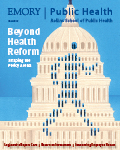Getting Down to Business

Ron Goetzel, director of the Emory Institute for Health and Productivity Studies
Ron Goetzel finds that influencing employee health yields big dividends
By Pam Auchmutey
In the United States today, 157 million adults—approximately 50% of the nation's population—spend half or more of their waking hours at work.
|
|
What better place, Rollins research professor Ron Goetzel believes, to improve health.
As director of the Emory Institute for Health and Productivity Studies (IHPS), Goetzel devotes the bulk of his waking hours to working with employers to find effective ways to promote employee health, heighten worker productivity, and reduce unnecessary health care costs.
Based in Washington, D.C., IHPS engages faculty, master's students, and doctoral students from the Department of Health Policy and Management in its studies. A key collaborator is Robert W. Woodruff Professor and department chair Ken Thorpe, whom Goetzel has known for more than 20 years. The two met when they worked for Medstat, known today as Truven Health Analytics, an IHPS partner, for whom Goetzel serves as vice president of consulting and applied research.
"Ken's work has been instrumental in shaping health policy and unearthing the root causes of health care cost increases," says Goetzel. "Those increases are driven by disease states and the risk factors that precede them, such as obesity, poor diet, sedentary lifestyle, and smoking. His work is very much in line with my interests. I approach health promotion from a business perspective to help employers figure out what they can do, what's within their power and reach, to influence the health and well-being, and ultimately the performance, of their workers."
The employers whom Goetzel counsels and studies read like a Who's Who of business and government: Lockheed Martin Corporation, PepsiCo, PPG Industries, the U.S. Department of Defense, the National Institute of Occupational Safety and Health (NIOSH), the Centers for Medicare and Medicaid Services, and insurance companies like American Specialty Health of San Diego. Goetzel also aided Discovery Health, the largest health insurer in South Africa, in gathering data to identify that nation's healthiest companies.
New projects are planned or just beginning. Goetzel is working with the U.S. Office of Personnel Management in Washington, D.C., to pilot an initiative for federal workers and with Prudential Financial to study how telecommuting affects employee health. This past summer, the health commissioner of Baltimore contacted Goetzel to discuss what the city could do to promote health and wellness for its employees.
"We spend a lot of time thinking about ‘promising practices' in health and productivity management—what can employers do to achieve a healthy company culture? What are the magic ingredients for that?" says Goetzel. "We help promulgate best practices, documenting that they actually work and produce positive health and financial outcomes for employers and their workers."
A shining example
|
"The HealthScoreCard is definitely going to be used. A lot of large organizations tend to emphasize health promotion because they have the resources to do it. We want the CDC scorecard to work for smaller organizations as well." Karen Kent 12MPH, Emory Institute for Health and Productivity Studies |
At one point in his career, Goetzel worked for the company that others look to as a pioneer in making employee health and wellness a priority. In 1978, Johnson & Johnson introduced its Live for Life program to encourage healthy behaviors among employees. James Burke, the company's CEO at the time, backed the program, firmly believing that promoting employee health and positive lifestyle decision-making could reduce rising health care costs.
"The positive outcomes related to the program began to surface immediately," writes Goetzel in a 2012 collection of research papers for NIOSH. "Johnson & Johnson work sites that implemented Live for Life had 18% lower absenteeism rates and one-third the medical expenses as their counterparts without access to Live for Life."
Guided by Johnson & Johnson's example, other companies have implemented programs to create a culture focused on employee health. A few years ago, Dow Chemical Company participated in a five-year study funded by the National Heart, Lung, and Blood Institute and led by IHPS in partnership with Thomas Reuters, the University of Georgia, and the National Business Group on Health. The project examined a comprehensive, evidence-based approach to weight management using a series of environmental interventions.
More than 2,400 employees at 12 company locations took part in the study, which focused on environmental and ecological changes that Dow could make to reduce overweight, obesity, and related risks. The study tested the effectiveness of individual interventions versus a combination of individual and environmental interventions.
All employees underwent health risk assessments and biometric screenings for weight, BMI, blood pressure, cholesterol, and blood glucose. At each intervention site, Dow provided healthier food choices in cafeterias and vending machines and at meetings, promoted exercise by making stairways more inviting and creating walking trails, and encouraged behavior change through communication and employee recognition. At five intervention sites, leaders also were trained to assume an even stronger role in promoting health in the workplace.
Two years into the study, results showed that intervention group participants maintained their weight, while control group participants gained weight. Intervention group participants also experienced positive changes in eating habits, physical activity, blood pressure, and cholesterol.
|
Dow Chemical Company installed walking tracks at various worksites to promote weight management for employees as part of a study led by the Emory Institute for Health and Productivity Studies. |
"It was important to apply evidence-based practices in the work setting in order to understand what environmental factors could influence employee health," says John White, global heath promotion and culture leader at Dow. "We have learned a lot about the application of environmental interventions in the workplace and continue to implement them to improve the health of our workers."
The company also conducted a prospective return on investment analysis that predicted a 1% annual decrease in obesity and other health risks among employees would save the company approximately $62 million over 10 years in health care costs alone.
"The beauty of environmental interventions is that once they're in place, they're solid," Goetzel says. "The idea is to introduce policies and programs that are inexpensive and easy to maintain over time. Dow continues to have an aggressive health management program and strategy."
In another study funded by CDC, IHPS sought to determine how public-private health partnerships could benefit employees. The study examined the impact of introducing the New York City Department of Health and Mental Hygiene's Wellness at Work Program at 10 major employers, including Columbia University, Con Edison, and the NYC Transit Workers Union. The study involved 9,000 participants.
NYC employers involved in the health promotion program saw modest improvements in healthy behaviors and self-reported biometric metrics, similar to those from another public-private initiative in Seattle and surrounding King County. That initiative targeted 12,000 county employees, including teachers, firefighters, police officers, and sanitation workers.
"We saw reductions in 12 of 14 health risks and a bend in the cost curve," says Goetzel. "The county realized $26 million in savings from the initiative after four years."
The economics of obesity
In an essay that he wrote for NIOSH's 2012 report, Goetzel points to obesity and its consequences as a "striking example of the clash between workers' health and economic growth." According to CDC figures from 2003, he notes, obesity-related disorders led to 39.3 million lost workdays, 239 million restricted activity days, and 62.7 million doctor's office visits among U.S. businesses.
To help turn the tide, CDC rolled out its LEAN Works! website in 2009. Drawing on materials from the CDC Guide to Community Preventive Services, LEAN Works! offers ideas for policies, programs, and tools to reduce obesity rates in the workplace.
In early September, CDC launched the Worksite Health ScoreCard, a tool that employers large and small can use to assess their health promotion programs, identify gaps, and prioritize steps to prevent heart attack, stroke, and related conditions. IHPS developed the scorecard in collaboration with CDC, state health departments, and worksite experts. The new online tool is based on the recommendation of the Community Preventive Services Task Force, on which Goetzel serves.
Karen Kent 12MPH began working on the scorecard during her first year at Rollins in 2010. The first phase of the project—developing a 100-item survey for employers to use—had just ended. For the second phase, Kent recruited 150 employers to pilot the online tool, conducted interviews and site visits, analyzed the data, and wrote a report for CDC's National Center for Chronic Disease Prevention and Health Promotion.
The Health ScoreCard generated quite a bit of buzz before it was launched, Kent says. Care was taken to design a tool for businesses with 10 to 10,000 employees. It provides employers with instant feedback showing how well they score in areas such as tobacco control, diabetes, and high blood pressure, and it provides guidance for implementing the policies, programs, and environmental supports that are truly impactful.
"It's definitely going to be used," says Kent, now an IHPS staff member in Washington. "We made sure that the scorehard has broad appeal and applicability. A lot of large organizations tend to emphasize health promotion because they have the resources to do it. We want the CDC scorecard to work for smaller organizations as well."
Kent recently began working with the Samueli Institute in Alexandria, Virginia, to develop an Optimal Healthy Environment-Workplace (OHE-W) tool that employers can use to assess health promotion programs and the work environment. "The CDC Health ScoreCard focuses on chronic disease prevention," Kent explains. "The OHE-W tool will be broader in some ways. It will look at the work environment, employer-employee relations, and behavioral health in addition to general wellness."
Two years from now, Kent and Goetzel will be among those watching when a provision of the Affordable Care Act takes effect for employers. The provision will allow employers to provide differential insurance premiums, set at 30%, as incentives for employees to adopt healthy lifestyles.
"It will provide more encouragement for employers to adopt effective health promotion and programs," Goetzel says. "Employers and employees will have a definite stake in the outcome."
To download the CDC Health ScoreCard, visit bit.ly/healthscorecard.




